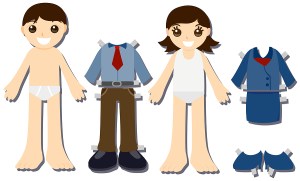You’re Wearing That?

Never has this been more important. With recruiters, HR professionals and hiring managers scouring what they can off the internet to ensure candidate fit and wedge social recruiting into their budgets, your personal brand is out there. Many interviews start before anyone picks up a phone or shoots an email reply.
By now, most candidate should be familiar with the standard advice. Lock down your profile, take care to post professional (or at least not revealing /provocative/controversial) pictures, try not to tweet anything your mother couldn’t handle. But what about the more subtle stuff? Clothes and personal appearance can be distracting for both parties in an in person interview. How can you be sure that you are putting out an in-person experience that’s in alignment with the self you project on social networks?
Personal Branding Blog author William Arruda says:
Though you may be a lot more comfortable interacting with people behind your computer screen, nothing can replace the deeper connections that are formed when connecting with someone face to face. So the next time you connect with someone genuinely online, invite them out for coffee. Who knows what opportunities can come up with meeting this person face to face.
Simply put, if you are a confident and knowledgable person online, don’t clam up when you’re face to face with a client or candidates. Candidates should heed the same advice. Heather Humann from Come Reccomended writes:
Keep The Conversation Going.Since you’re aware about what you tweet and post, try to extend that same expertise when it comes to starting a conversation. It doesn’t have to all industry-related, but keep the talk professional nonetheless.
It extends to clothing and style as well. While it certainly doesn’t hinder one’s ability to get a job or secure the perfect candidate, take care to look similar to your picture. If you hairstyle has changed drastically in the last year (okay three years) update your photo. If you are sporting a baseball cap in all your social media profiles, but show up in a pressed suit, it’s startling.
Rules and regulations will vary from company to company, but there are some hard and fast rules about how to look in an interview. This handy infographic from AOL Jobs lays out the criteria for various positions quite nicely.
In this discussion on Quora, a bunch of startup guys chimed in on what they expect when an interviewee walks through the door. The bar varies with position, bottoming out with, “we don’t care, as long as you don’t smell.”
Recruiters have done thousands of interviews and have a pretty good handle on the process. The checklist of expectations regarding the candidate is long and often tough to fill. Barry at Impact Solutions tells candidates:
Our interview is a dress rehearsal of how you will interview when you meet my client. Every meeting, regardless of how informal it might appear, is an interview and candidates should treat them as such. There are rarely do overs.
So give your candidate an indicator of what you’d like them to wear, or how they should dress. Even when it should seem obvious, you get a different response from nearly every blog and article, every professional and recruiter. When a recruiter or HR Professional makes it part of their preparation process to go over the basics (not hygiene, that should be a given) of aligning personal branding initiatives, if applicable, to in-person dress and demeanor, the process goes much more smoothly.

